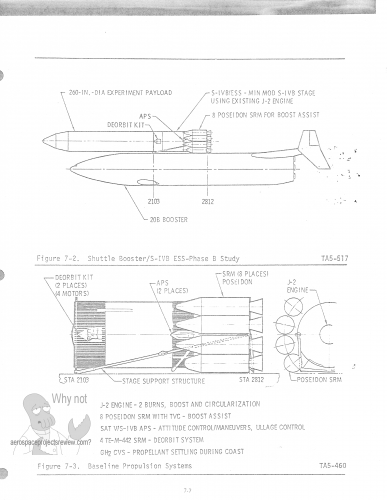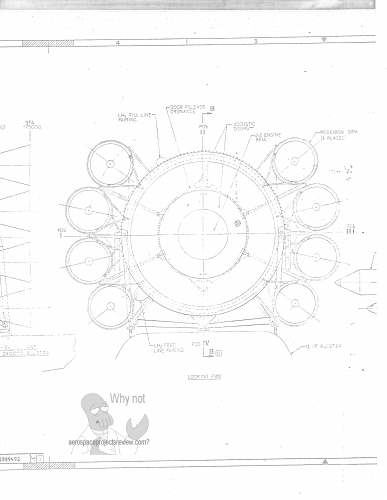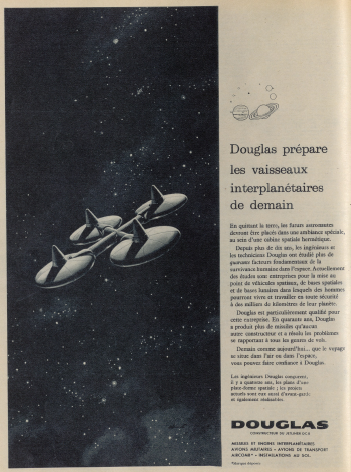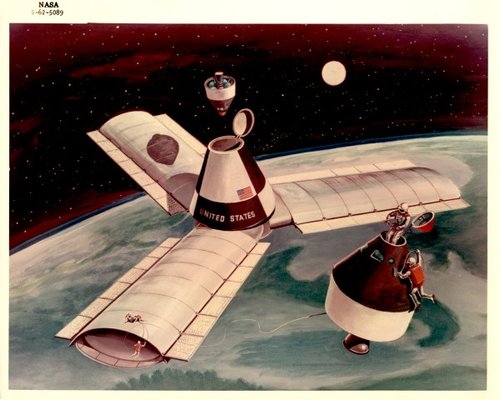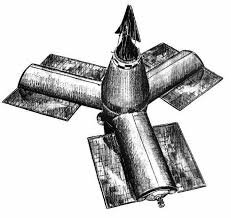You are using an out of date browser. It may not display this or other websites correctly.
You should upgrade or use an alternative browser.
You should upgrade or use an alternative browser.
Space Station Concepts
- Thread starter Barrington Bond
- Start date
- Joined
- 31 December 2006
- Messages
- 803
- Reaction score
- 363
pometablava said:George,
Could you please attach the picture here?. Not everyone has an account in Twitter or Facebook and any link send us to "please sign here" page
Oh sorry everyone, and thanks to Arjen for posting those. I forgot that Twitter now requires two letters of recommendation and a chest X-ray in order to sign up.
- Joined
- 31 December 2006
- Messages
- 803
- Reaction score
- 363
My pleasure -- they're intriguing, aren't they? Like the third one -- lots of boost assist, but what's in that core? Is that a regular S-IVB or some kind of 10-meter sideways stretch to match the other space station concepts of the era?
- Joined
- 13 August 2007
- Messages
- 8,446
- Reaction score
- 11,001
the Logo on Picture is McDonnell-Douglas
I guess those are Part of Space Station study McDD made for NASA on Phase B Space Station Study 1969/70
interesting is that third Picture a Launch Rocket it's feature a S-IVB stage separate from a stage with 8 solids
never see this version of Saturn Hardware
I guess those are Part of Space Station study McDD made for NASA on Phase B Space Station Study 1969/70
interesting is that third Picture a Launch Rocket it's feature a S-IVB stage separate from a stage with 8 solids
never see this version of Saturn Hardware
Michel Van said:interesting is that third Picture a Launch Rocket it's feature a S-IVB stage separate from a stage with 8 solids
never see this version of Saturn Hardware
That's part of the Shuttle program, surprisingly enough. I've seen a few reports on this concept, which was an alternate upper stage for the Shuttle back when it had a manned flyback booster. Instead of the manned orbiter, the idea was to use an expendable upper stage for heavier payloads. The reason why the solids were on the *sides* of the S-IVB rather than *behind* the S-IVB was so that the stage could sit on the back of the booster, rather than ahead of the booster as in the Saturn.
- Joined
- 31 December 2006
- Messages
- 803
- Reaction score
- 363
The S-II was also looked at as an upper stage for the shuttle booster in this period.
https://ntrs.nasa.gov/archive/nasa/casi.ntrs.nasa.gov/19730006138.pdf
Edit: Added Rockwell study reference.
https://ntrs.nasa.gov/archive/nasa/casi.ntrs.nasa.gov/19730006138.pdf
Edit: Added Rockwell study reference.
- Joined
- 13 August 2007
- Messages
- 8,446
- Reaction score
- 11,001
Thanks for Info and Picture !
- Joined
- 9 October 2009
- Messages
- 21,973
- Reaction score
- 13,623
(h/t The Artist & Michel Van)
I would have really liked to have seen this thing demonstrated in space. A 200 meter long beam would have been an impressive sight and provided data which might have allowed alternatives to the ISS truss structure. This Langley video shows a similar beam builder which seems to use a more mechanistic assembly process.
The S-II was also looked at as an upper stage for the shuttle booster in this period.
Edit: Added Rockwell study reference.
This... is... fantastic.
About the SOC - JSC logic behind it was pretty horrific. Judge by yourself...

The Space Station Decision
Outstanding Academic Title, 1991, Choice MagazineAlthough building a space station has been an extraordinary challenge for America's scientists and engineers, the securing and sustaining of presidential approval, congressional support, and long-term funding for the project was an enormous task...books.google.fr
Quote of note
"Let's don't build [a space station] that caters to the users; we'll build one that is an operational base, a facility, and then what we'll do is just let the users come on board and when they come on board they will have to make their own beds.
Something I meant to comment on earlier but missed
In context, (and I have to finish reading this one to see if it goes there
At the time, (and something that we know now is true but wasn't as clear then) the general "wants" of the various science and other 'users' that NASA was asking for input were very much mostly mutually exclusive in nature. The science missions clashed with the industrial and research missions and vice-versa. And keep very much in mind that what NASA was aimed for was a space station that would be used as an orbital assembly and support post for post-Lunar exploration above all else. So even when you could get several 'customers' into a possible relationship quite often NASA would side-line or ignore their needs while putting their own needs at a higher priority, which in and of itself would drive off those customers.
And then add on top of that the fact that while Congress had made no bones about NASA's need to lower its sights post-Apollo, NASA essentially shrugged off and ignored the warning and kept placing the space station as both the next big project AND the first stepping stone to forcing Congress to authorize a near-term Mars mission.
Essentially the 'customers' could have been and would have been better served by a series of smaller stations, but NASA wanted an operational orbit base from which to push on exploring with all other considerations secondary because that's essentially how Apollo was done and NASA no longer knew how to do anything different. We're seeing it repeated today as more and more 'sustainable' and 'infrastructure building' elements of the new push are sidelined or put on the back-burner in favor of getting certain goals done as quickly as possible so as to use public and political support while it lasts.
Randy
just musing, other than the early BIS. studies, were there any UK. 'space station' studies from industry ?
cheers, Joe
cheers, Joe
- Joined
- 1 November 2009
- Messages
- 638
- Reaction score
- 428
No doubt the inspiration for the K-7 Deep Space Station seen in the Trouble With Tribbles episode of Star Trek.From Aviation magazine,the Douglas.
Paul Lloyd
I really should change my personal text
- Joined
- 21 May 2012
- Messages
- 29
- Reaction score
- 114
Contractor's model for the McDonnell Douglas Phase B station and my not-very-accurate CGI model of it.
I read that it would spin, to give 1/6 g in the cylinder and 1/3 g in the cone. Power would have been provided by a couple of nuclear isotope generators (enclosed in conical aeroshells in case they had to be jettisoned) -0 the red blisters on the contractor's model.
More images of the contractor's model here



I read that it would spin, to give 1/6 g in the cylinder and 1/3 g in the cone. Power would have been provided by a couple of nuclear isotope generators (enclosed in conical aeroshells in case they had to be jettisoned) -0 the red blisters on the contractor's model.
More images of the contractor's model here
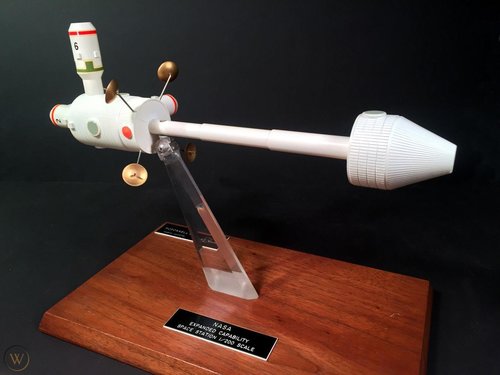
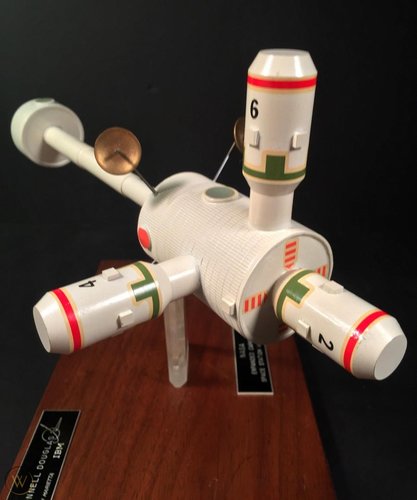
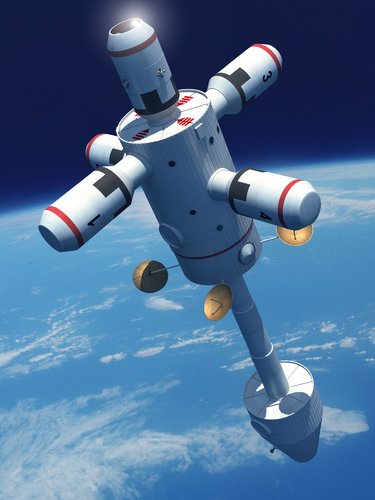
FighterJock
ACCESS: Above Top Secret
- Joined
- 29 October 2007
- Messages
- 5,607
- Reaction score
- 5,934
Contractor's model for the McDonnell Douglas Phase B station and my not-very-accurate CGI model of it.
I read that it would spin, to give 1/6 g in the cylinder and 1/3 g in the cone. Power would have been provided by a couple of nuclear isotope generators (enclosed in conical aeroshells in case they had to be jettisoned) -0 the red blisters on the contractor's model.
More images of the contractor's model here
View attachment 630009View attachment 630010View attachment 630011
An interesting design for a space station Paul Lloyd, I like the early 1950s space station designs.
- Joined
- 25 June 2014
- Messages
- 1,564
- Reaction score
- 1,499
Of all the space station concepts I think the spokes-without-a-rim idea is the most practical. To avoid health problems, the things have to spin for artificial gravity, with a minimum radius of perhaps 10 m (30 ft) or more. Anything smaller and imagine how it would be for your head and arms to double in weight when you stand up and start walking across the room but your legs to stay the same, or to turn and bend over a table to put something down and both it and you lose weight as you go; your body would interpret the weight changes as acceleration.... But a big 20 m diameter wheel has 63 m of rim, which takes some building, so why not just build a couple of lollipops on sticks and stop there? The difficult engineering bit would have been to keep the central hub stationary for docking, but modern technologies can do that easily enough. I made one co-star of an SF novella, not so long ago.
Of all the space station concepts I think the spokes-without-a-rim idea is the most practical. To avoid health problems, the things have to spin for artificial gravity, with a minimum radius of perhaps 10 m (30 ft) or more. Anything smaller and imagine how it would be for your head and arms to double in weight when you stand up and start walking across the room but your legs to stay the same, or to turn and bend over a table to put something down and both it and you lose weight as you go; your body would interpret the weight changes as acceleration.... But a big 20 m diameter wheel has 63 m of rim, which takes some building, so why not just build a couple of lollipops on sticks and stop there? The difficult engineering bit would have been to keep the central hub stationary for docking, but modern technologies can do that easily enough. I made one co-star of an SF novella, not so long ago.
Talking of minimum diameter, anyone know what diameter 2001's Discovery habitat section was.
- Joined
- 16 April 2008
- Messages
- 9,605
- Reaction score
- 14,494
Talking of minimum diameter, anyone know what diameter 2001's Discovery habitat section was.
The novel says the ball was 40-feet (12.2-m)in diameter; Kubrick's film set was a 38-ft (11.6m) diameter "hamster wheel." Probably too small for comfortable pseudo-gravity.
- Joined
- 25 June 2014
- Messages
- 1,564
- Reaction score
- 1,499
The novel says the ball was 40-feet (12.2-m)in diameter; Kubrick's film set was a 38-ft (11.6m) diameter "hamster wheel." Probably too small for comfortable pseudo-gravity.
That would approx 15% gravity variation head-to-toe. I'd guess OK for selected astronauts, not for unfit travellers. I wonder if there are stats on it somewhere?
FighterJock
ACCESS: Above Top Secret
- Joined
- 29 October 2007
- Messages
- 5,607
- Reaction score
- 5,934
Thought I posted this already but I can't find it doing a search and not much else going on. This is a Studio Ghibli video created for a client. Total fantasy but entertaining with a catchy tune.
Nice find fredymac.
Talking of minimum diameter, anyone know what diameter 2001's Discovery habitat section was.
The novel says the ball was 40-feet (12.2-m)in diameter; Kubrick's film set was a 38-ft (11.6m) diameter "hamster wheel." Probably too small for comfortable pseudo-gravity.
Discovery III looks like it could give a better gravity.
Would the Leonov have still been able to clamp onto Discovery in 2010 with this design?
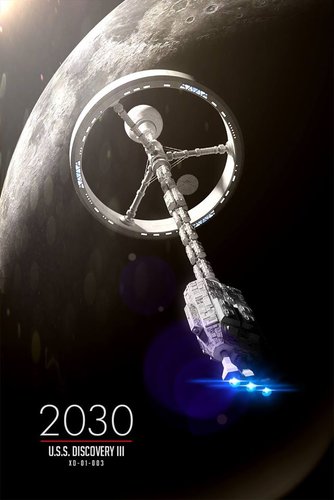
- Joined
- 4 July 2010
- Messages
- 2,514
- Reaction score
- 3,091
The Leonov was quite a bit shorter than Discovery, it's possible there could be enough clearance if she was clamped far enough aft. But the mass distribution issues would probably be even worse. Knowing Clarke's writing, though, there would probably be a system to jettison the ring in an emergency. Since Chandra was the only one on Discovery during the burn, no reason to keep the habitat around if you can discard that mass before the burn.Talking of minimum diameter, anyone know what diameter 2001's Discovery habitat section was.
The novel says the ball was 40-feet (12.2-m)in diameter; Kubrick's film set was a 38-ft (11.6m) diameter "hamster wheel." Probably too small for comfortable pseudo-gravity.
Discovery III looks like it could give a better gravity.
Would the Leonov have still been able to clamp onto Discovery in 2010 with this design?
View attachment 633251
- Joined
- 1 November 2009
- Messages
- 638
- Reaction score
- 428
In fairness to Kubrick and the rest of the crew, they likely knew that but had to go with too small. I'm sure one of the limiting factors on the design of that set was the height of the soundstage ceiling/roof.Talking of minimum diameter, anyone know what diameter 2001's Discovery habitat section was.
The novel says the ball was 40-feet (12.2-m)in diameter; Kubrick's film set was a 38-ft (11.6m) diameter "hamster wheel." Probably too small for comfortable pseudo-gravity.
Last edited:
martinbayer
ACCESS: Top Secret
- Joined
- 6 January 2009
- Messages
- 3,397
- Reaction score
- 3,904
Is that available for reading?I made one co-star of an SF novella, not so long ago.
- Joined
- 25 June 2014
- Messages
- 1,564
- Reaction score
- 1,499
Is that available for reading?I made one co-star of an SF novella, not so long ago.
Nobody Steals My Air: And Other Stories Also available from Amazon, Barnes & Noble, iBookstore, etc.
All online reviews gratefully received.
- Joined
- 9 October 2009
- Messages
- 21,973
- Reaction score
- 13,623
Paul Lloyd
I really should change my personal text
- Joined
- 21 May 2012
- Messages
- 29
- Reaction score
- 114
- Joined
- 9 October 2009
- Messages
- 21,973
- Reaction score
- 13,623
- Joined
- 9 October 2009
- Messages
- 21,973
- Reaction score
- 13,623

Meet Starlab: Private Space Station Planned To Fly In 2027 - Slashdot
Nanoracks, Voyager Space and Lockheed Martin announced today (Oct. 21) that they plan to get a free-flying private space station up and running in low Earth orbit (LEO) by 2027. Space.com reports: The outpost, called Starlab, is envisioned to be a tourist destination as well as a research and...
science.slashdot.org
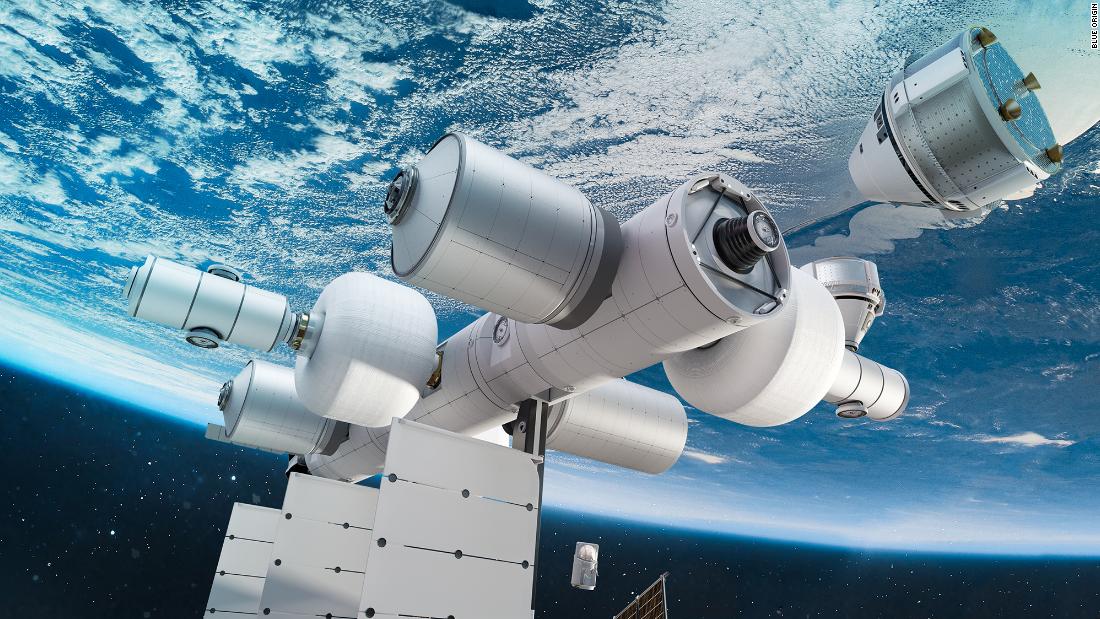
Jeff Bezos' Blue Origin wants to build a tourism space station nearly as big as the ISS
Blue Origin, the rocket and space tourism company founded by Jeff Bezos, is proposing a massive new commercial space station called "Orbital Reef" that could be used to host science experiments, vacation getaways, and potentially even in-space manufacturing.
Would there be any way to find the name of McDonnell Douglas'es Director of Truss Structures for the U.S. space station Freedom around 1991-1992?
Buz Hynes
buzhynes@gmail.com
720.979.6337
Buz Hynes
buzhynes@gmail.com
720.979.6337
Who? and why is it notable?Gene Myers is looking at SLS cores as in ET stations.
Wondering if anyone knows or could find the name of the Director of Truss Structures for McDonnell Douglas in the final days of Freedom's design.
I can't remember or find it. I'm writing a memoir about my non-linear design to replace the platform's equilateral triangle truss structures that we were R&D'ing before congress pulled the plug!
I can't remember or find it. I'm writing a memoir about my non-linear design to replace the platform's equilateral triangle truss structures that we were R&D'ing before congress pulled the plug!
Similar threads
-
Orbital Technologies commercial space station
- Started by FutureSpaceTourist
- Replies: 6
-
-
-
-
Stealing secrets from the ether: missile and satellite telemetry interception during the Cold War
- Started by Flyaway
- Replies: 4

